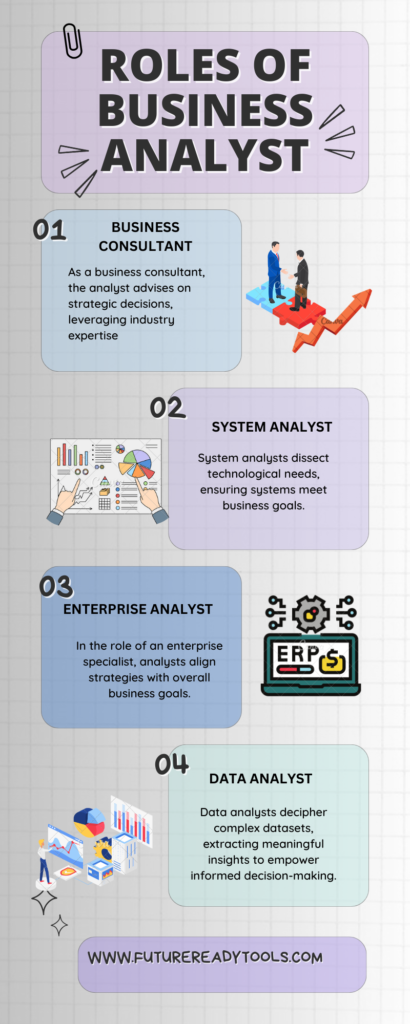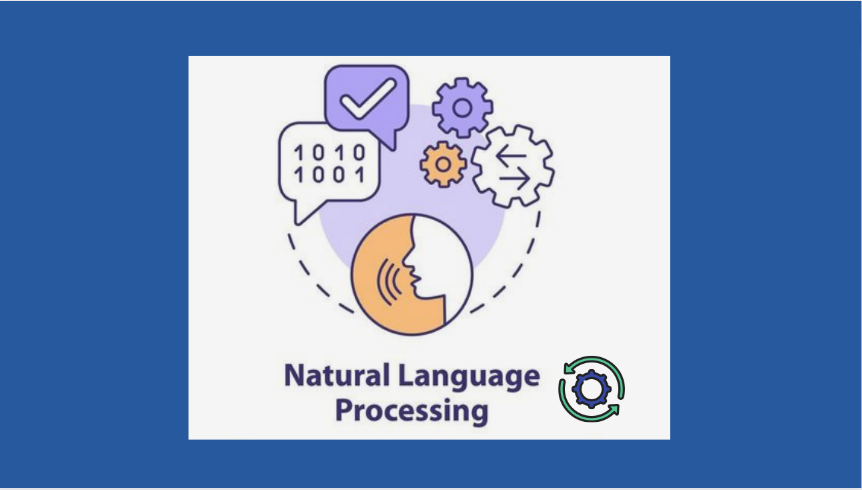The role of a Business Analyst (BA) has become increasingly important as businesses continue to develop and adapt to technological advancements and dynamic market trends. In this article, we will explore the multifaceted aspects of the BA role and why it stands as a future-ready career.
- Introduction to the Business Analyst Role
- The Core of Business Analysis
- The Rise of Business Analysts Across Industries
- The Business Analysts Guide to Adapting to Technological Changes
- The Expansive Role of a Business Analyst in Modern Business
- Skills required for a Business Analyst
- Carving a Path to Becoming a Business Analyst
- The Forward-Thinking World of Business Analysis
- Career Progression as a Business Analyst
- A Day in the Life of a Business Analyst
- Starting the Journey of Organizational Understanding: Gathering Requirements
- Deciphering the Complexities of Data: Analyzing Information
- Transforming Numbers into Engaging Narratives: Creating Reports
- Navigating Collaboration: Working with Teams
- Discovering Paths for Improvement: Identifying Opportunities
- Tools and Technology for the Future-Ready Business Analyst
- Staying Up-to-Date with Tech Trends
- Conclusion: The Strategic Importance of Business Analysts
- FAQs
Introduction to the Business Analyst Role

What is a Business Analyst?
A Business Analyst is a pivotal player in any organization, catalyzing change and improvement. Their primary goal is to align business processes with technological advancements and market trends, ensuring the organization remains competitive and efficient. They achieve this by delving into the business structure, using data analysis to understand current practices, and identifying areas ripe for enhancement.The BA’s primary goal is to align business processes with technological advancements and market trends, ensuring that the organization remains competitive and efficient.
The Core of Business Analysis
Business analysis involves a comprehensive understanding of the complex workings of an organization. This includes analyzing business models, processes, and systems to identify inefficiencies and recommend solutions. Business Analysts work persistently to bridge the gap between IT and business departments, ensuring that technological solutions meet business requirements effectively.
The Rise of Business Analysts Across Industries
Proficient Business Analysts are in demand across various industries in today’s ever-changing industrial landscape. They play a vital role in improving patient care systems in healthcare, ensuring a seamless and enhanced healthcare experience. Similarly, in the finance sector, Business Analysts streamline and optimize investment strategies, resulting in transformational changes. As architects of innovation and efficiency, Business Analysts are the driving force behind diverse industries, using their analytical skills to leave a lasting impact on the ever-develop business landscape.
In the world of healthcare skilled Business Analysts are architects of change, meticulously improving systems, for patient care. Their expertise helps create an improved healthcare experience driving efficiency and innovation within institutions. Through analyzing data and providing insights, Business Analysts make contributions to optimizing healthcare workflows, ultimately benefiting both patients and healthcare providers.
Similarly, in the changing landscape of the finance industry, Business Analysts utilize their skills to streamline and optimize investment strategies. Armed with data driven insights, they navigate through environments by identifying opportunities and managing risks. The transformative impact of Business Analysts in finance is evident as they bring about changes that ensure efficiency and effectiveness in making investment decisions.
In both the healthcare and finance sectors, Business Analysts play a role in shaping the future by leveraging data analysis to drive changes. Their strategic contributions not enhance efficiency but also pave the way for innovation, making them vital figures in the ongoing evolution of these important industries.
The Business Analysts Guide to Adapting to Technological Changes
As technology continues to advance at a rapid pace, the role of the Business Analyst is undergoing a transformative shift. In today’s era dominated by big data, artificial intelligence (AI), and the Internet of Things (IoT), Business Analysts play a crucial role in seamlessly integrating these cutting-edge technologies into the fabric of business strategies. Their expertise extends beyond mere proficiency, as they actively navigate and harness the potential of big data, AI, and IoT to drive innovation and efficiency.
In this developing landscape, Business Analysts not only demonstrate mastery in utilizing these tools but also possess the foresight to anticipate and strategically integrate emerging technologies. With their proactive approach, they surpass mere adaptation to change. Business Analysts stand as architects of technological evolution, charting a course for businesses to not only keep pace with change but to thrive in the ever-shifting technological landscape. Their active engagement and foresight position them as instrumental figures in shaping the future trajectory of business in the digital age.
The Expansive Role of a Business Analyst in Modern Business
Key Responsibilities and Impact
Business Analysts excel in diverse roles as data interpreters, process innovators, and communication bridges. They conduct strategic market analyses, document business needs through requirement gathering, and oversee the design and implementation of effective business solutions.
The Many Hats of a Business Analyst: Guiding Business Success
Business analysts are multi-faceted professionals who play a crucial role in the success and evolution of businesses. From strategic analysis to solution design and implementation, they wear many hats and contribute to multiple aspects of the business. Let’s take a closer look at some of their key roles and responsibilities.
Strategic Analysis: Steering Business Direction
One of the most critical roles of a business analyst is to act as a strategic analyst. They engage in thorough market analysis, providing valuable insights that steer the strategic direction of the business. By having a keen understanding of market trends and competitor landscapes, they contribute significantly to informed decision-making at the strategic level.
Requirement Gathering: Unveiling Business Needs
Business analysts also adapt requirement gatherers. They excel at identifying and meticulously documenting the essential needs of the business. By engaging with stakeholders, they ensure a comprehensive understanding of both explicit and implicit requirements, laying the groundwork for effective solution development.
Solution Design and Implementation: Architects of Efficiency
The journey of a business analyst extends to solution design and implementation. They serve as architects of efficiency, taking charge in developing and overseeing the deployment of business solutions. With a blend of technical expertise and strategic vision, business analysts play a crucial role in ensuring that proposed solutions align seamlessly with the identified business needs, fostering growth and innovation.
Collaboration and Communication: Facilitating Business Success
In addition to their technical skills, business analysts excel in collaboration and communication. They work closely with stakeholders, including managers, developers, and end-users, to ensure that business needs are understood and met. They also facilitate communication between different teams and departments, ensuring that everyone is on the same page and working towards shared goals.
In this dynamic and ever-evolving business landscape, business analysts emerge not just as professionals wearing many hats but as indispensable contributors driving the success and evolution of businesses. Their ability to guide business direction, unveil business needs, design and implement solutions, and facilitate collaboration and communication makes them an invaluable asset to any organization.
Skills required for a Business Analyst
To succeed in the role of a business analyst it is crucial to possess a rounded skill set that combines both technical and non technical competencies.
Technical Business Analysts:
- Data Analysis:
It is essential to have proficiency in tools like SQL, Excel, Tableau, Power BI and statistical analysis software such as R or Python. These skills empower business analysts to extract insights from datasets enabling them to make data driven recommendations. - Business Intelligence (BI) Tools:
Familiarity with BI tools like SAP BusinessObjects, IBM Cognos or Microsoft Power BI is necessary. Business analysts rely on these tools to create reports, dashboards and interactive visualizations that provide insights to stakeholders. - Process Modeling and Analysis: Enhancing Business Efficiency
Business analysts who possess expertise in process modeling techniques like BPMN (Business Process Model and Notation) and proficiency in process analysis tools such as ARIS or Visio play a role in improving efficiency. By utilizing these skills they. Analyze business processes identify inefficiencies and propose enhancements for streamlined operations. - Agile Methodologies: Navigating Collaborative Agility
A vital skill for business analysts is having an understanding of methodologies like Scrum or Kanban along with familiarity with Agile project management tools such, as JIRA or Trello.
Experienced business analysts who are well versed in methodologies can effectively collaborate with development teams play a role, in sprint planning and actively participate in Agile ceremonies to ensure adaptive and efficient project management. - For business analysts working closely with development teams it is crucial to understand the phases of the Software Development Life Cycle (SDLC). This understanding ensures coordination throughout the project life cycle – from conceptualization to implementation – facilitating project execution.
6. Database and SQL: A solid foundation in databases and SQL is essential for business analysts. Proficiency in databases such as Microsoft SQL Server, MySQL and Oracle DB is important, for working with data. Additionally knowledge of NoSQL databases empowers analysts to access, retrieve, manipulate and analyze data efficiently.
Non Technical skills
Analytical and Critical Thinking
Business analysts need to be able to decipher client requirements with precision. They need to have strong analytical and critical thinking skills to assess multiple options and come up with well-informed and effective solutions. By prioritizing business requirements, they can navigate challenges and achieve goals even in resource-constrained and non-ideal conditions.
Communication and Interpersonal Skills
Effective communication and interpersonal skills are vital for business analysts. The ability to communicate concisely with stakeholders and clients is as crucial as understanding requirements. Throughout various project phases, business analysts utilize verbal and written communication to convey ideas, facts, and opinions. A proficiency in communication and interpersonal skills instills confidence in business analysts, particularly during meetings and collaborations.
Negotiation and Cost-Benefit Analysis
Negotiation skills are a cornerstone for every business analyst. They play a pivotal role in defining project visions, prioritizing requirements, and making technical decisions. Business analysts also employ cost-benefit analysis to assess the expected costs and benefits of projects. This strategic approach aids in decision-making at the project initiation stage, ensuring that organizations embark on projects with a clear understanding of the associated costs and benefits.
Decision-Making Skills
Business analysts must possess strong decision-making skills. Their decisions have a direct and indirect impact on a company’s business. Before presenting a decision, business analysts meticulously interpret problems, explore alternative business approaches, and test these alternatives. The final decision is grounded in a thoughtful analysis of these approaches, ensuring comprehensive consideration of all relevant aspects.
Collaboration and Teamwork

Business analysts often function within cross-functional teams, making collaboration and effective teamwork vital. They need to be able to work harmoniously with team members, enhancing overall productivity and project success. Business analysts adept at collaboration bring diverse skills and perspectives together, fostering an environment conducive to innovation and efficiency.
Carving a Path to Becoming a Business Analyst
Minimum Educational Requirement: Bachelor’s Degree
To embark on a career as a business analyst, a minimum requirement is a bachelor’s degree in business administration or a related field. This undergraduate education equips individuals with core competencies in accounting, analytics, finance, and marketing, laying the groundwork for a successful career in business analysis. Practical experience gained after earning a bachelor’s degree is essential to develop the hands-on skills crucial for success in the field.
Master’s Degree
For those aspiring to enhance their credentials and unlock advanced career opportunities, pursuing a master’s degree is a strategic move. Both a master’s in business analytics and an MBA are popular choices, each taking one to two years to complete. These graduate degrees not only elevate qualifications but also position individuals for roles with higher responsibilities and increased earning potential.
Certifications
Certified Business Analysis Professional (CBAP):
The CBAP certification, offered by the International Institute of Business Analysis (IIBA) is widely recognized as one of the certifications, for business analysts worldwide. It showcases an individuals knowledge and expertise in business analysis practices. To be eligible candidates must have work experience in business analysis. Successfully pass a comprehensive examination.
Certification of Competency in Business Analysis (CCBA):
Also provided by IIBA CCBA is specifically designed for business analysts with a level of experience. It serves as a stepping stone towards achieving CBAP certification. Requires candidates to demonstrate their understanding of business analysis principles and practices.
PMI Professional in Business Analysis (PMI PBA):
Offered by the Project Management Institute (PMI) PMI PBA certification focuses on integrating business analysis within the project management framework. This certification is suitable for professionals who aim to align their business analysis skills with project management practices to ensure project delivery.
Certified Analytics Professional (CAP):
CAP, provided by the Institute for Operations Research and the Management Sciences (INFORMS) caters to analysts specializing in data analytics. While not exclusively targeted at business analysts it offers insights, for professionals seeking to enhance their data driven decision making abilities.
The Certification in Business Analysis (CBA):
This isoffered by the Indian Institute of Business Analysis (IIBA) India Chapter aims to promote and advance the profession of business analysis in India. It holds recognition, within the business analysis community.
Similarly mentioned earlier as CBAP certification the Indian Institute of Business Analysis (IIBA) India Chapter also provides support to business analysts pursuing this globally recognized certification.
The Forward-Thinking World of Business Analysis
Trends Shaping the Future of Business Analysis
As the world becomes increasingly digital and data-driven, the role of the Business Analyst (BA) continues to evolve. Here are three trends shaping the future of business analysis:
- Data Democratization: Making Data Accessible for Better Decision-Making Across Departments
In the past, data was often siloed within individual departments, making it difficult for different teams to collaborate effectively. However, with the rise of data democratization, businesses are breaking down these barriers and making data accessible to everyone.
This trend is driven by the growing recognition that data is a valuable asset that can be used to drive better decision-making. By making data available to all employees, businesses can empower their teams to make more informed decisions and drive innovation.
As a result, BAs are increasingly responsible for designing and implementing systems that enable data democratization. They must be able to work with stakeholders across departments to understand their data needs and develop solutions that meet those needs.
- Customer-Centric Analysis: Using Data to Enhance Customer Experiences
As businesses become more focused on customer experience, BA’s are playing an increasingly important role in helping businesses understand customer needs and preferences.
Customer-centric analysis involves using data to gain insights into customer behavior, preferences, and pain points. BAs must be able to analyze customer data from a variety of sources, including social media, surveys, and transactional data, to identify trends and opportunities for improvement.
To be successful in this role, BA’s must be able to work closely with marketing and customer experience teams to understand their needs and develop solutions that meet those needs.
- Sustainability and Ethical Analysis: Aligning Business Practices with Sustainable and Ethical Standards
As businesses become more aware of their impact on the environment and society, BAs are increasingly responsible for ensuring that business practices align with sustainable and ethical standards.
This trend involves analyzing business practices to identify areas where improvements can be made to reduce environmental impact, promote social responsibility, and ensure ethical conduct.
BA’s must be able to work with stakeholders across the organization to understand their sustainability and ethical goals and develop solutions that meet those goals. They must also be able to stay up-to-date on the latest sustainability and ethical standards and trends to ensure that their solutions are effective and relevant.
Career Progression as a Business Analyst

The role of a Business Analyst offers many opportunities for growth and advancement. With the right skills and experience, BAs can progress to senior roles such as Senior Business Analyst, Project Manager, or Chief Technology Officer. These positions often require a deep understanding of business operations, strategic thinking abilities, and excellent communication skills to lead teams effectively. Ultimately, the career trajectory of a Business Analyst depends on their interests and willingness to learn and adapt to new challenges.
A Day in the Life of a Business Analyst
Starting the Journey of Organizational Understanding: Gathering Requirements
In the realm of a business analyst’s routine one of the crucial tasks is to gather requirements. This involves diving into the intricacies of needs and expectations, for specific projects or solutions. By conducting interviews, surveys, workshops, and analyzing documents business analysts meticulously. Document information. Although it’s not an occurrence this responsibility serves as a cornerstone that ensures the outcomes align with the organization’s overarching objectives.
Deciphering the Complexities of Data: Analyzing Information
Every day business analysts immerse themselves in the art of data analysis. This intricate duty entails examining qualitative data to uncover patterns, trends, and valuable insights. Equipped with techniques like data visualization, statistical analysis, and predictive modeling analysts unravel the complexities within the data landscape. This daily ritual empowers informed decision-making processes by optimizing operations and identifying areas, for improvement. Through this lens, business analysts become architects who design strategies driven by data to efficiency and gain an edge.
Transforming Numbers into Engaging Narratives: Creating Reports
A significant portion of a business analyst’s day is dedicated to crafting reports that tell the story behind their findings, recommendations, and project progress. These reports provide insights, into how an organization operates the opportunities it has, and the challenges it faces. They help with making decisions and strategic planning. Analysts use their skills to present data through charts, graphs, and visual aids. This daily task serves to communicate information effectively while promoting transparency, collaboration, and a culture of data-driven decision-making.
Navigating Collaboration: Working with Teams
In the world of dynamics, business analysts collaborate with different stakeholders to gain a comprehensive understanding of their needs. Managers, subject matter experts, technical teams, and employees all play roles in this process. Through meetings, workshops, and digital communication channels business analysts weave together perspectives. Participating in these interactions allows them to uncover needs and contribute significantly to overall success.
Discovering Paths for Improvement: Identifying Opportunities
A part of a business analyst’s journey involves continuously seeking opportunities for improvement. In this role, analysts act like detectives in search of ways to enhance efficiency, competitiveness, and profitability. By using tools such, as gap analyses, benchmarking, and data-driven assessments they evaluate existing processes to identify inefficiencies and propose solutions.
Tools and Technology for the Future-Ready Business Analyst

Data Analysis Tools: Proficiency in data analysis tools is fundamental for a Business Analyst. Some of the most commonly used tools include Microsoft Excel, SQL, and R. With Excel, BAs can perform various statistical analyses, create pivot tables, and generate charts and graphs to better understand large data sets. SQL, on the other hand, is essential for database management. BAs use SQL to extract and manipulate data from databases, allowing them to identify patterns, trends, and insights. R is a programming language used for statistical computing and graphics, making it an excellent tool for data visualization and analysis.
Business Intelligence Software :Mastery of Business Intelligence (BI) software is another essential skill for a Business Analyst. BI software like Tableau, Power BI, or QlikView helps BAs create interactive dashboards and reports that transform complex data sets into easy-to-understand visualizations. With BI software, BAs can identify trends, patterns, and insights that can inform business decision-making. These tools are a must-have for any BA who wants to deliver actionable insights to business stakeholders.
Project Management Tools: Project management tools like JIRA, Trello, or Asana help BAs manage their workflow, collaborate with teams, and track the progress of their projects. With these tools, BAs can create task lists, assign tasks to team members, and set deadlines. Project management tools also facilitate communication between team members, allowing them to share ideas, files, and feedback. By using project management tools, BAs can streamline their work processes and ensure that their projects are completed on time and within budget.
Emerging Technologies
Artificial Intelligence and Machine Learning :
Understanding the basics of Artificial Intelligence (AI) and Machine Learning (ML) can help Business Analysts in predictive analytics and making data-driven decisions. AI is a subset of computer science that aims to create intelligent machines that can perform tasks typically requiring human intelligence, such as visual perception, speech recognition, decision-making, and language translation. ML, on the other hand, is a subset of AI that involves training algorithms to learn from data and improve over time without being explicitly programmed. BAs who understand AI and ML can leverage these technologies to develop predictive models that can inform business decisions and optimize business processes.
Blockchain Technology:
Knowledge of Blockchain technology can be beneficial for Business Analysts, especially in industries like finance and supply chain. Blockchain is a distributed ledger technology that allows for secure and transparent peer-to-peer transactions without the need for intermediaries like banks or governments. BAs who understand Blockchain can help organizations leverage this technology to streamline business processes, reduce costs, and improve security. For example, in supply chain management, Blockchain can be used to track the movement of goods from manufacturers to retailers, ensuring transparency and accountability at every step of the process. In finance, Blockchain can be used to facilitate secure and transparent transactions, reducing the risk of fraud and error.
Staying Up-to-Date with Tech Trends
Continuous learning is incredibly important. It can be achieved through means such, as courses, webinars, or attending industry conferences. Staying updated with the advancements ensures that Business Analysts (BAs) maintain relevant and future-ready skills.
For BAs who want to enhance their skills and knowledge, the International Institute of Business Analysis (IIBA) offers a range of resources, certifications, and training programs. Here are some key offerings available through IIBA:
1. IIBAs Endorsed Education & Training: This program endorses a variety of education and training options provided by organizations. It supports the development of business analysis professionals at all levels from entry-level to positions.
2. IIBA KnowledgeHub: This resource hub provides information on business analysis, including tips, tools, and templates. It serves as a starting point for newcomers to business analysis while also offering insights for seasoned professionals looking to deepen their knowledge.
3. Business Analysis Competency Model: This model outlines the skills and competencies required for business analysis. It can serve as a guide for development in this field.
4. Entry Certificate in Business Analysis (ECBA™): This certification focuses on knowledge according to the BABOK® Guide. It is specifically designed for individuals who are new to business analysis and covers concepts and techniques.
External link : https://www.iiba.org/business-analysis-certifications/ecba/
5. Certified Business Analysis Professional (CBAP®): The CBAP® certification is designed for individuals who have experience, in business analysis. To obtain this certification candidates must have accumulated 7,500 hours of Business Analysis Work experience within 10 years along with meeting other requirements.
External link : https://www.iiba.org/business-analysis-certifications/cbap
6.CBAP® Online Proctoring: This option allows candidates to conveniently take the CBAP® exam online from any location providing flexibility and ease.
These resources and certifications can greatly enhance the skills and marketability of a Business Analyst ensuring they possess the abilities to tackle the challenges and demands of business environments.
For information and to explore these resources further please visit the IIBA website:
External links: https://www.iiba.org/
Business Analyst Vs Product Manager
The roles of a Business Analyst and a Product Manager may overlap in some areas but also have distinct differences in focus and responsibilities.
Orientation and Focus:
Product Managers are primarily outward-facing as they concentrate on understanding market dynamics and customer needs. They play a role throughout the lifecycle of a product from conceptualization, to launch guiding cross-functional teams through the product development process. The main role of individuals, in this position is to gain an understanding of customer issues and ensure that the team is developing solutions aligning the development of products with the company’s strategic goals.
On the other hand, Business Analysts focus more on operations. They concentrate on analyzing and enhancing business processes, systems, and data. Their role is crucial in comprehending business requirements, collecting and documenting information well, and recommending solutions for specific challenges. They often serve as a connection between business stakeholders and IT teams working towards meeting the demands expressed by Product Managers on behalf of customers and the market.
Roles and Responsibilities:
A Product Manager establishes the strategy and roadmap for a product. They gather feedback from customers prioritize features and collaborate with engineering, design, and marketing teams to ensure success while aligning with business objectives. A Business Analyst focuses on analyzing both business processes and systems. Their goal is to identify areas that can be improved upon while also working together with stakeholders to define the project scope. They play a role, in documenting business requirements as well as assisting in testing and validation efforts.
Skills and Tasks:
Product Managers and Business Analysts are two distinct roles that require different skill sets and tasks. Product Managers are responsible for creating and managing a product’s vision and roadmap. They need to have skills in strategic thinking, customer empathy, product design, market research, and data-driven decision-making. Some of the typical tasks performed by Product Managers include conducting user interviews, managing product backlogs, and prioritizing features based on customer needs.
Output
The output of a Business Analyst includes business process documentation, requirement specifications, and recommendations for business process improvement. In conclusion, while Product Managers and Business Analysts have different skill sets and tasks, they both play an essential role in ensuring the success of a business. By working together, they can create products that meet customer needs while improving business processes to streamline operations and stay competitive in their respective industries.
Conclusion: The Strategic Importance of Business Analysts
To sum it up, Business Analysts are not merely intermediaries, they are strategic partners who play a vital role in driving businesses towards greater efficiency, innovation, and growth. As the business landscape continues to evolve at a rapid pace, the role of the Business Analyst becomes increasingly crucial and in high demand. With their analytical skills, technical proficiency, and excellent interpersonal skills, Business Analysts are poised to lead businesses towards greater success and prosperity in the future.
FAQs
What tools do Business Analysts use?
- Business Analysts typically use a variety of tools, including office tools like Microsoft Excel, Word, PowerPoint, Google Docs, Sheets, and Slides, project management tools such as Trello, Jira, Confluence, Asana, database languages like SQL, and UX wireframes tools like Balsamiq, UXPressia, Figma, Adobe XD.
What documents do Business Analysts work with?
- Common documents used by Business Analysts include Business Cases, Business Analysis Documents, Business Requirement Documents, Use Cases Documents, System Requirements Specification Documents, Functional Requirements, Non-functional Requirements, Data Mapping Requirements, Risk Analysis Documents, Request for Proposal, Project Plan, Wireframes, Gap Analysis, User Acceptance Testing Progress Report, Test Cases, Project Progress Report, and Handover Document.
What kinds of diagrams does a Business Analyst work with?
- Business Analysts work with diagrams such as Use Case Diagrams, Activity Diagrams, Collaboration Diagrams, Flowcharts, Data Flow Diagrams, Sequence Diagrams, Entity Relationship Diagrams, and Class Diagrams.
What are project deliverables?
- Project deliverables are tangible or intangible results produced at each project stage, delivered internally or to shareholders and clients. These include various reports, documents, proposals, drawings, strategies, and final products and services.
What is the difference between requirements and needs?
- A requirement is a targeted solution to achieve specific business objectives, thoroughly documented for reference. Needs are high-level representations of the terms and results.
How can you say that a requirement is perfect?
- A good requirement is Specific, Measurable, Attainable, Relevant, and Timely (SMART). It should be specific and comprehensive, with measurable success criteria, attainable and relevant resources, and revealed timely.
What is the purpose of the Requirement Traceability Matrix?
- It records all the client’s requirements, ensuring that all the necessities are met.
What is business modeling?
- Business modeling is a step-by-step approach for identifying the value proposition for operating the business, involving elements like Vision, Mission, Objectives, Strategies, and Action plan.
What is the project life cycle?
- The project life cycle is a framework splitting a project into manageable phases, signifying decision points throughout the project lifespan. Models like the Waterfall model, Spiral model, Iterative model, Agile model, and V-shaped model are employed based on the project’s type, scope, and limitations.
What is Gap Analysis, and what types of gaps can occur?
- Gap Analysis is the analysis of differences between the functionalities of an existing and targeted system. Gaps like Profit Gaps, Manpower Gap, Performance Gap, and Market Gap can occur.





